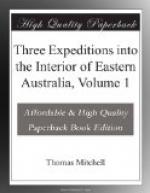A FRIENDLY NATIVE WITH HIS FAMILY.
At thirteen miles, being again in a wood, we heard the native axe at work, and, naturally eager to communicate with or even see the faces of fellow-creatures in these dismal solitudes, I allowed Dawkins to go towards them unarmed, that he might, at least by signs, ascertain where water was to be found. A considerable time having elapsed without his reappearance, I went after him, and found him in communication (by signs) with a very civil native, who had just carried a quantity of wild honey to his gin and child, having first offered some to Dawkins. This man betrayed no signs of fear, neither had he any offensive weapons, but he refused to accompany Dawkins to the rest of the party, rather inviting the latter, by signs, to accompany him. For water, he pointed both to the north-east and south-west, and all around, as if it had been abundant; numerous pigeons and kangaroos also showed that there was some at no great distance; nevertheless we were doomed to pass another night without any, after a long day’s journey.
NO WATER.
On quitting the wood where we met the native we crossed a plain which appeared to slope westward. Night was coming on, and I directed my course towards some tall trees, where we found a hollow, but no water remained in it; yet here we were nevertheless obliged to encamp. Some of the men who had set out in search of water had not returned when it became dark; but on our sending up a rocket they found their way to the camp, although they had not succeeded in their search for water.
From this camp the summits of the Nundewar range were still visible, and very useful in determining our longitude. One cone in particular (Mount Riddell) promised from its height to be a landmark still on these northern plains. (See below, outline of summits as seen on 12th January.)
REACH THE GWYDIR.
Continuing our journey at half-past five A.M. over the clear plain, we came upon several ponds, distant not more than a mile from where we had passed the night. We lost no time in watering the cattle and proceeding. At half a mile beyond I perceived on the right some very green grass by the edge of a hollow, overhung by spreading eucalypti. I found there a fine lagoon of considerable extent, and brim-full of the purest water. There were no reeds, but short grass grew on the brink, and near the shore a few waterlilies. Here we filled our keg and kettles. We next crossed some slightly rising ground, and high in the branches of the trees I perceived, to my astonishment, dry tufts of grass, old logs, and other drift matter! I felt confident that we were at length approaching something new, perhaps the large river, the Kindur of The Bushranger. On descending by a very gentle slope, a dark and dense line of gigantic bluegum-trees (eucalyptus) growing amid long grass and reeds, encouraged our hopes that we had at length found the big river. A narrow tract of rich soil




